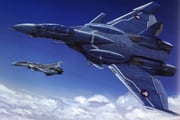Edit
A typically circular symbol. The term is used in heraldry, but also commonly used to refer to a type of national insignia used on military aircraft, generally circular in shape and usually comprising concentric rings of different colours.
Notable examples:
- United States has circle with a white star, with two white or white-and-red bars on the left and right side.
- Japan has a single red circle, mostly bordered with white stylized after the Japanese flag.
- Germany has a black iron cross with white borders.
- Britain has a blue, white, and red circle.
- Canada, Australia, and New Zealand replace the circle with a maple leaf, a kangaroo, and a kiwi bird respectively.
- France has a red, white, and blue circle.
- Italy has a red, white, and green circle. During World War II, it has white circle bordered in black with three black fasces in it.
- Soviet Union had a five-pointed red star with white border. Belarus also uses this roundel after the collapse of the USSR, while Russia added blue border between the white and red section.
- China also has a red star, but with a Chinese text meaning "8.1" and bordered by two red yellow-bordered bars.
- Taiwan and the former Republic of China uses Kuomintag "white sun" symbol" contained within blue circle.
- Sweden has a blue circle bordered in yellow with three gold crowns in it.
- Poland has a red and white checkerboard design.
- South Korea has a red and blue yin-yang bordered with three black bars on either side.
- Israel has a blue six-pointed star on a white circle.
- Indonesia has a white red-bordered pentagon design.
- The Philippines has a blue, white, and red diamond with wings.
- Finland has a white, blue, and white circle design. Formerly, they used a blue swastika on a white circle.


